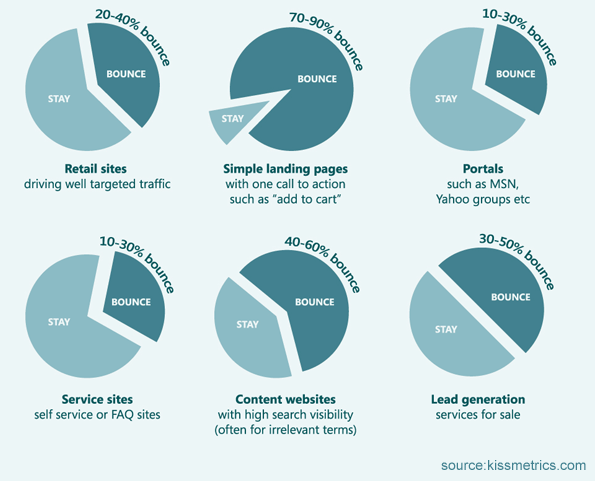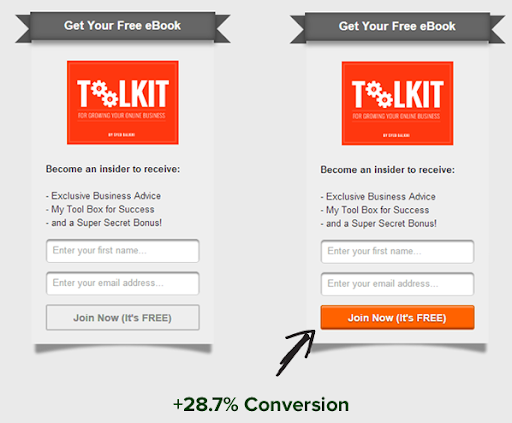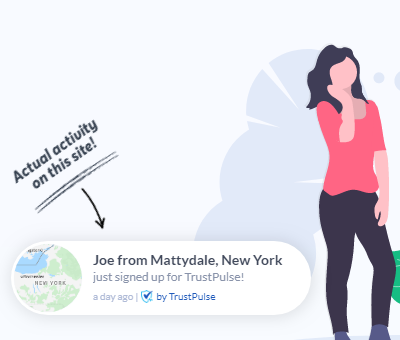Do you have an unusually high bounce rate? Are you looking for a way to keep customers on your website? Are you just now hearing the term bounce rate and want to know more? If you answered “yes” to any of these questions, you’re in the right place.
First, let’s define the term bounce rate. Your bounce rate represents the percentage of consumers that leave your website without navigating to a second page. The purpose of your business is to keep customers engaged, build trust, and encourage future sales. You’ll never get to accomplish any of these tasks with consumers that leave without fully exploring what you have to offer.
Let’s look at the average bounce rate by industry:
If you’re running a retail site, you should have a bounce rate between 20 and 40 percent. You can find your bounce rate by checking your Google Analytics on-site. What do you do if your percentage is slightly higher, or even double the average? We are going to take a look at four easy tricks you can use to improve your bounce rate in 2020.
Split Test Everything
Split testing, also known as A/B testing, is one of the most powerful tools you have at your disposal when you want to reduce your bounce rate. If one of your pages has an abnormally high bounce rate, you may find yourself getting frustrated because you can’t figure out which aspect of your page is causing people to leave.
You can split test virtually everything on your website, including colors, placement, text, and images. Essentially, a split test occurs when you create a page that’s considered baseline normal. You then make small changes to that existing post, contact form, or lead magnet to see if your change causes more consumers to stick around and shop around on your site. You should run both the baseline normal page and the variant you are split testing at the same time; this will let you gather data in real-time.
For example, here’s a split test showing a color change in the call-to-action.
Even though the change seems subtle at first, switching the subscribe button from white to orange boosted conversions by 28.7 percent. If more consumers are converting on your page, there’s a good chance that your bounce rate will change with your improved conversion rate.
Show Social Proof
Social proof is a psychological phenomenon where people are more likely to buy a product if they see other people enjoying the same brand. Remember when people were camping in front of Apple stores to get the latest iPhone? That’s social proof in action.
This trend helps sell iPhones, but social proof is also an excellent way to improve your bounce rate. When a consumer lands on your page for the first time, they want to see other people using your product or service and having a pleasant experience.
You can boost your social proof on-site in several different ways. The most common way to build social proof is by featuring testimonials from industry experts or happy customers on your website. Try to find a way to include testimonials on all of your pages. For example, you could include some of the highlights under your company logo.
Additionally, you can use a social proof tool that shows visitors what other consumers are doing on your website. Let’s say someone visits your landing page, and while they are there, five new people subscribe to your mailing list. Letting the new visitor know what everyone else is doing encourages them to stay on your website longer, which improves your bounce rate. Here’s what it looks like in practice:
Simplify Your UX
Have you ever visited a poorly designed website? If so, did you stick around to see what kind of products or services that business offered? Our guess is you joined their bounce rate statistics. If you want to keep consumers on your website beyond the first page, you have to build a comprehensive site that focuses on a stellar user experience for first-time visitors and long-time subscribers alike.
User experience goes beyond how your website looks; it also includes how well it functions. Can someone find your businesses’ contact page from every major section of your website? If not, users might land on your site and have questions, but don’t know how to ask. Instead of looking around, they immediately leave and forget your business exists.
If you want to simplify your UX, start by looking at the foundation of your website. Make sure users can navigate to each section of your site without getting redirected. You should also look over your website’s copy to make sure you are clear and concise in your blog posts and when explaining the benefits of your product. When you consider that 87 percent of visionaries and 81 percent of leaders believe that content is a pillar of their marketing strategy, this is one tip you can’t afford to skip.
Target Customers after They Bounce
You can apply these tips and more to your strategy, and you will still see at least 30 percent of visitors bounce from your site. There are plenty of reasons this could happen. The most common reason is the person on your page ended up getting distracted, and the page timed out. Consumers will also leave your website if they land there expecting information on a specific topic, only to see that the content doesn’t exist on your blog.
Start by targeting customers on social media or through email if they signed up for your mailing list. Let’s say someone had to go back to work and didn’t get a chance to complete their purchase. You can send them a friendly email letting them know that they abandoned their cart, or you can create a retargeting ad that shows a special discount to that consumer while they are browsing social media.
The goal is to convince people that were close to checking out your site to come back. While their first visit will count as a strike towards your bounce rate, the eventual conversion will help lower the bounce percentage.
Conclusion
Improving your bounce rate can have a tremendous impact on the success of your website. Unfortunately, there’s no one-size-fits-all solution. Factors such as your existing audience, site design, and marketing campaigns also play a role in how people respond when they land on your page.
The more you get to know your target audience and what they expect from your business, the better chance you have at improving your bounce rate. These tips will help steer you in the right direction and help you reduce the number of people leaving your page, but you may have to make fundamental changes to your strategy as your business develops.


